new posts in all blogs
Viewing: Blog Posts Tagged with: Oxford University press, Most Recent at Top [Help]
Results 26 - 50 of 58
How to use this Page
You are viewing the most recent posts tagged with the words: Oxford University press in the JacketFlap blog reader. What is a tag? Think of a tag as a keyword or category label. Tags can both help you find posts on JacketFlap.com as well as provide an easy way for you to "remember" and classify posts for later recall. Try adding a tag yourself by clicking "Add a tag" below a post's header. Scroll down through the list of Recent Posts in the left column and click on a post title that sounds interesting. You can view all posts from a specific blog by clicking the Blog name in the right column, or you can click a 'More Posts from this Blog' link in any individual post.

By: Maggie Belnap,
on 6/22/2014
Blog:
OUPblog
(
Login to Add to MyJacketFlap)
JacketFlap tags:
Oxford University Press,
whistle,
*Featured,
mcnamara,
James Cook,
Life at Oxford,
Maggie Belnap,
Brady McNamara,
Coming Up Short,
Dog Whistle Politics,
Ian Haney Lopez,
jacket covers,
Jennifer Silva,
white—ears,
design,
Books,
Sociology,
Politics,
book design,
Add a tag
By Maggie Belnap
Despite the old saying, a book’s cover is perhaps the strongest factor in why we pick up a book off the shelf or pause during our online web shopping. Of course, we all like to think that we are above such a judgmental mentality, but the truth is that a cover design can make — or break — a book’s fortunes.
Brady McNamara, Senior Designer at Oxford University Press, admitted that designing book covers isn’t as easy as one might think.
“To create a book jacket,” McNamara explained, “You have to first understand book’s concept. I have about 75 books at a time to design jackets for. That’s just too much. To help, I have about 10-12 really great freelance designers who really know what OUP is all about.” He continued, “I also always try one or two new freelancers each go around. Sometimes they work, and sometimes they don’t. That’s kind of what happened to Dog Whistle Politics.”
Ian Haney Lopez’s book, examining how politicians use veiled racial appeals to persuade white voters to support policies that favor the rich and threaten the middle class, is a difficult concept to capture. “It was a particularly tough cover to design: the subject just doesn’t lend itself to one concrete image,” McNamara agreed. He and his freelancer toiled over numerous cover drafts.
Dog Whistle Politics Design 1:
McNamara: “This is the initial sketches shown by our freelancer, I really liked [the] 1950’s clip art man. It had a kitchiness and style typical to ‘the conservative establishment.’ However, the cover review panel (editor and marketing manager) thought the starburst frame seemed out of place, like vintage advertising.”
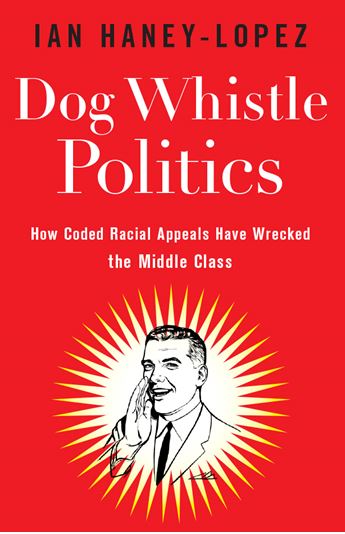
Dog Whistle Politics Design 2:
McNamara: “In another sketch, the designer used a black background and surrounded our clip art guy with symbols of the economy and arrows illustrating its downfall. It was arbitrary and yet too obvious; just didn’t feel right.”

Dog Whistle Politics Design 3:
McNamara: “[The] editor suggested that an actual image of a dog could work. The sketch was submitted but not shown. I made a personal call that it was too gimmicky and distractingly odd. It was weird, and a not funny weird.”
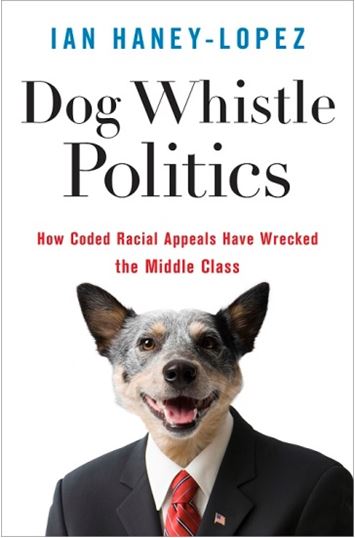
Dog Whistle Politics Design 4:
“I finally took the design on myself,” says McNamara, laughing slightly as he remembers the process. “I had a pretty good idea of what we needed by now. It really wasn’t the freelancer’s fault, again, it’s just one of those books that is tough to design for. I tried an image of a bull dog and after the author mentioned a dog whistle, I incorporated that into the title. Nothing more literal I guess. The bulldog turned out to be too cute.”
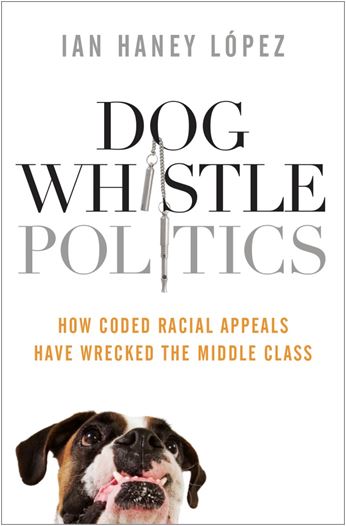
Dog Whistle Politics Design 5:
McNamara: “I tried a more menacing Doberman in black and white—ears pricked up as if hearing the whistle. I also brought a serious tone back to the design by using just red, gray, and black type. This was finally approved. Not the most esoteric design, but it stands out on the shelf – if only for those pointy ears.”

While McNamara struggled with the concept for Dog Whistle Politics, design is a collaborative process.
James Cook, an Oxford University Press editor, discussed the pressing dilemmas of the design process: “I know the book best and worked with it the longest, so I understand the themes and perhaps have some ideas about how they can be illustrated.” He serves as a translator to the designer from the book itself and the author. “I talk with the author and try to relay his or her wishes to the designer, while also making sure the book and title are being represented. A cover needs to align, interpret, and reflect the books themes accurately, while also being attractive to a buyer.”
One of his titles, Coming Up Short, a book that sheds light on what it really means to be a working class young adult with all its economic insecurity and deepening inequality, also went through a number of cover jackets before finding the right fit.
Coming Up Short Design 1:
“One of the first designs was a girl in a skirt, sitting on a swing in the park,” remembers Cook. “It certainly portrayed what we wanted, but also had a sexual predator vibe as well.”
“I didn’t have a good feeling about the first cover I saw,” the author Jennifer Silva confessed. “I thought it had a kind of Lolita vibe when mixed with the title of the book. I expressed my concern, and it turned out that others at Oxford agreed.”
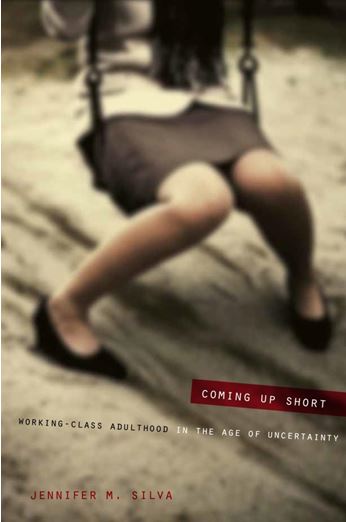
“Jen was great to work with,” Cook acknowledged. “Sometimes it becomes difficult going back and forth trying to satisfy everyone’s wishes while also finding a good portrayal of the book. Sometimes authors just don’t want certain colors or schemes in the cover, and it’s my job to make sure they are heard.”
Coming Up Short Design 2:
After several other drafts, everyone agreed on a jacket: saturated yellow with multiple ladders.
“I love it,” raved Silva. “It feels young, modern, and hip. It’s not too literal, and also looks great on a bookshelf.” When asked about if the experience of jacket designing was frustrating or stressful, Jen waves the issue away saying, “No, it was fun to go back and forth!”

Not all books are as design-intensive as Dog Whistle Politics and Coming Up Short. Cook says, “Some academic books are easy because you can follow a certain style that is well known and easily recognized as being a textbook.”
However, there are always a few books along the way that keep designers and editors nimble.
Maggie Belnap is a Social Media Intern at Oxford University Press. She attends Amherst College.
Subscribe to the OUPblog via email or RSS.
The post Books by design appeared first on OUPblog.

Who says today's children are being dumbed down? Who says the intelligence, literacy and creative ability is weakening compared to previous generations? (Could it be Michael Gove?)
I personally detest it when people put down children in this way. Any writer or teacher who goes out to meet kids in schools knows how smart they are. I believe that modern technology has made them far smarter than us oldies were at their age. They have a wider vocabulary and a much greater appreciation of the world, brought about by the broadened horizons made available by the Internet, games, books and a smörgåsbord of television channels. They probably also travel much more widely than we did 50 or more years ago.
All of this has had a marvellous effect. This is underlined by the results of BBC Radio 2's and the Oxford University Press' 500 words competition for children announced a few days ago, in which children had to compose an original work of fiction of 500 words.
They received a record-breaking, staggering 118,632 entries. Wow. Oxford University Press dictionary's team has analysed the stories to find out what words kids are using the most and the extent of their vocabulary, etc., all stuff that is of interest to us writers.
The most interesting thing first of all is the gender split. Girls outnumbered boys entering the competition by about 2 to 1. Three quarters of the entrants were in the 10 to 13 age range, the rest being nine and under. That probably means that girls in that age range are more likely to read books than any other children.
Now: how reassuring that the most common noun used in the stories is: 'mum'; and the most common adjective: 'good'.
Despite the fact that girls wrote twice as many of the stories, the main protagonist is more likely to be a boy. Now why do you think that is?
And the commonest name, used 27,321 times, is Jack, closely followed by Tom, Bob and James, all solid Anglo-Saxon names. I was certainly surprised to find that the most common girl's name is Lily/Lilly (17,981), closely followed by Lucy, then Emily and Sophie, also traditional English names.
And the most common historical figure? Adolf Hitler (used in 641 stories) followed by Queen Victoria (258).
I'd like to see Nigel Farage and his ilk use this as evidence for the insidious infiltration of multiculturalism into British culture. Actually it goes to show the opposite: there is no cause for concern, if anyone is concerned, that British culture is being watered down (although the research results are not accompanied by an ethnicity breakdown of the entrants to enable us to determine whether Celtic or Anglo-Saxon-originating Brits are unevenly represented amongst the entrants).
Looking at the keywords used in the stories, children were especially interested by this year's floods, with that single noun being by far the most commonly used (4008 uses), followed largely by non-real-world originating terms, coming from films and computer games: Lego, minion (used in Despicable Me), Minecraft and flappy (from the game Flappy Bird). Other words commonly used derived either from games or recent events such as the Winter Olympics.
What about new words? The research found that popular culture and social media have given rise to new verbs such as 'friended', 'Facebooked' and 'face-planted'. These will no doubt be finding their way into the next edition of OUP's children's dictionary.
Now for the really good news: children know - and are not afraid to use - really long words, including some that you or I may not even know: how about 'contumelious'? As used in the following context:
The girl springs to her feet losing all caution and apoplectic with outrage. "How dare you?" she cries, "Fighting them is bad enough, but capturing one to be slaughtered, as if it were a common boar, is contumelious. They will take their revenge and it will be terrible." (The War Party, girl, 13)
Or hands up who knows what '
furfuraceous' means? As used in:
Folkrinne's crown was placed on his furfuraceous head. The Basilisks applauded and cheered for the corrination of their new king of Malroiterre. (The Basilisk king, girl, 12)
(OK, so there was a spelling mistake in that, but I forgive this author because I think furfuraceous is a lovely word, conjuring up such a beautiful image in my mind).
And what about
making up words? Children are not afraid to do this because, as you and I know, it is so much fun. My favourite made-up word quoted from the stories is '
historytestaphobia' because I absolutely used to suffer from that when I was at school. I also love '
Mucaologist', which is apparently a collector of mucus.
Finally, telling stories is not just about the words you know but the order in which you put them, and these children seriously know how to
build suspense using perfectly ordinary words. As the report writers say:
If asked to write on a theme of mystery and suspense, one would not immediately think of the words door, house, step, and walk and yet the following example shows clearly how these words can be used to build suspense:
'Something had caught his eye. He turned around and saw an old, creaky house standing on its own in the middle of the woods. He took one step towards the scary house. He got closer and closer until he reached the house. Ben slowly walked up the cracked steps to reach the front door. Ben was scared out of his skin. Although on the outside he was brave. He pushed the rotten door and took a step inside the house.' (Haunted House, boy, 11)
All of this makes me happy, because it shows that there will continue to be a hungry audience for anything we writers produce, and, moreover, in a few years' time there will be more fantastically creative young adults ready to take our place.
Let's hear it for the kids.

By: Kirsty,
on 4/10/2014
Blog:
OUPblog
(
Login to Add to MyJacketFlap)
JacketFlap tags:
Oxford University Press,
oup,
faberge,
*Featured,
arbitration,
belvedere,
conference guide,
commercial arbitration,
moot guide,
Vis Moot 2014,
moot,
schwenzer,
cisg,
juridicum,
cepani,
Law,
conferences,
Add a tag
By Isabel Jones
This weekend will see the oral arguments for the 21st Annual Willem C. Vis International Commercial Arbitration Moot begin in the Law Faculty of the University of Vienna, an exciting event for students, coaches, arbitrators, and publishers. This yearly event is a highlight in the arbitration event calendar and a chance for lawyers and students from all over the world to meet. Oxford University Press will have a stand in the main meeting place, the Juridicum, and we’re looking forward to showcasing our great selection of products.
With nearly 100 mooting teams, the moot promises to be a busy, vibrant, and sociable event. To find out more about this year’s problem, visit the moot website. In case you didn’t know already, this year’s moot will be using the CEPANI rules.
At the OUP stand you will be able to find plenty of copies of the essential text, Redfern and Hunter on International Arbitration. Last year we caught up with the authors to discuss the book and the future of international arbitration, watch the videos below to find out more.
Click here to view the embedded video.
Click here to view the embedded video.
Click here to view the embedded video.
Also available will be the second edition of Principles of International Investment Law by Rudolf Dolzer and Christoph Schreuer, and the third edition of Schlechtriem & Schwenzer: Commentary on the UN Convention on the International Sale of Goods (CISG) edited Ingeborg Schwenzer. If you come to the stand you will be able to demo the fantastic newly re-lauched online service Investment Claims on our iPads.
It’s hard not to notice that Vienna is a great location for this event, and with so much do to in between moots that you’ll be spoilt for choice. Once you’ve had a good look at the OUP stand, why not:
- Take a walk to the MuseumsQuartier, one of the largest cultural areas in the world. Here you can admire the mixture of baroque and modern architecture and visit a number of great galleries including Leopold Museum and the MUMOK
- Have a coffee and cake in Café Central, only a short walk from the Juridicum and offers a great coffee house experience
- Take a trip to the beautiful Schonbrunn Palace on the outskirts of Vienna
- See Klimt’s famous painting ‘The Kiss’ at The Belvedere
- Visit the amazing Faberge exhibition on at Kunsthistorisches Museum
- Explore the Easter markets nearby, where you can buy beautiful painted eggs (if you can get them home intact!) along with traditional Austrian food and drink
We’ll be setting up our stand early on Saturday (13 April) morning and will be packing up on Tuesday morning. Do come by and say hello if you’re at the Moot, we’re looking forward to seeing you!
Isabel Jones is Senior Marketing Executive in OUP UK’s Law department.
Subscribe to the OUPblog via email or RSS.
Subscribe to only law articles on the OUPblog via email or RSS.
The post Preparing for the Vis Moot 2014 appeared first on OUPblog.


By: Maria Donnini,
on 3/6/2014
Blog:
OUPblog
(
Login to Add to MyJacketFlap)
JacketFlap tags:
earning,
clarendon,
incomes,
*Featured,
payments,
Simon Eliot,
author earnings,
author payment,
Clarendon Press Series,
History of Oxford University Press,
John Feather,
nonfiction authors,
Selborne Commission,
W. Aldis Wright,
aldis,
‘clarendon,
liddell,
Books,
History,
Media,
Oxford University Press,
wright,
British,
19th century,
Add a tag
By Simon Eliot and John Feather
In the 1860s, the introduction of its first named series of education books, the ‘Clarendon Press Series’ (CPS), encouraged Oxford University Press to standardize its payments to authors. Most of them were offered a very generous deal: 50 or 60% of net profits. These payments were made annually and were recorded in the minutes of the Press’ newly-established Finance Committee. The list of payments lengthened every year, as new titles were published and very few were ever allowed to go out of print. Some authors did very well from their association with the Press, but most earned very modest sums. Many of the books in the Clarendon Press Series yielded almost nothing to publisher or author; once we exclude the handful of exceptional cases, typical payments were in the range of £5 to £15 a year.

W. Aldis Wright.
The outstanding financial successes of the Clarendon Press Series were the editions of separate plays of Shakespeare intended for school pupils and (increasingly) university students. The first to be published was Macbeth in 1869, but it was the next to appear – Hamlet in 1873 – which became something like a bestseller. In its first year, Hamlet sold 3,380 copies; 20 years and five editions later, 73,140 copies had been accounted for to the editor, W. Aldis Wright (a fellow of Trinity College, Cambridge), who received over the years some £1,400 for this play alone. The whole CPS Shakespeare venture brought Wright an income of about £1,000 a year throughout much of the 1880s. To put this in context, the total of all royalties paid to authors in the late 1880s and early 1890s was about £5000 a year; in some years Wright was taking about 20% of that for his editions of Shakespeare alone.
A broader view of the Press’s payments to its authors on the Learned side can be gained by looking at three sample years: 1875, 1885, and 1895. In November 1875, the Finance Committee minutes listed 99 titles for which authors were being paid annual incomes, the total sum being paid out was £2,216. In November 1885, near the peak of publishing activity in the Clarendon Press Series, the Finance Committee minutes listed 238 titles generating revenue for their authors; they earned £4,740 between them. In November 1895, there were 240 titles leading to payments of £5,076. For most authors, their individual incomes were modest; in 1875, the median income was £7 16s, in 1885 it was £7 18s. However, in 1875 four authors and editors earned more than £100: Liddell and Scott received £372 each (for their Greek Lexicon), Aldis Wright received £220 (for various editions of Shakespeare’s plays), and Bishop Charles Wordsworth £152 (for his Greek Grammar). In 1885, eleven were earning more than £100, including Aldis Wright earning £934, Liddell and Scott each earning £350, Skeat earning £270 (for philological works), and Benjamin Jowett earning £261 (for editions of Plato’s works). In 1895, there were ten, including Aldis Wright with £578, J. B. Allen with £542 (for works on Latin grammar), and Liddell and Scott with £389 each.
These authorial incomes should be set against average academic incomes in Oxford. In the later nineteenth century, although there was much variation, the average annual income for a college fellow would be in the order of £600, usually made up of the fellowship dividend plus the tutorial stipend. In the wake of the Selborne Commission, in the early 1880s a reader would be paid £500, a sum might well be augmented by a fellowship dividend; professorships attracted £900 per annum. It is clear that, although most authors’ incomes were extremely small, the most successful authors, both inside and outside the Clarendon Press Series, were at their height earning a significant addition to their salaries through payments from the Press.
The incomes of the most successful were far in excess of what they would have earned had they sold their copyrights outright. On the other hand, those around the median probably earned less than a lump sum payment would have brought in or, at least, they had to wait longer for it. As a minor compensation to those who were paid small annual sums during this period – though it is unlikely that they would have known it – the purchasing power of the pound was rising between the mid-1860s and the mid-1890s, so their later small payments would have bought them more than their earlier small payments. The pound in a person’s pocket was actually worth more at the end of the nineteenth century than it had been at the beginning.
Simon Eliot is Professor of the History of the Book in the Institute of English Studies, School of Advanced Study, University of London. He is general editor of The History of Oxford University Press, and editor of its Volume II 1780-1896. John Feather, a former President of the Oxford Bibliographical Society, is a Professor at Loughborough University and the author of A History of British Publishing and many other works on the history of books and the book trade. He has contributed to both volumes I and II of The History of Oxford University Press.
With access to extensive archives, The History of Oxford University Press is the first complete scholarly history of the Press, detailing its organization, publications, trade, and international development. Read previous blog posts about the history of Oxford University Press.
Subscribe to the OUPblog via email or RSS.
Subscribe to only British history articles on the OUPblog via email or RSS.
Image credit: William Aldis Wright (1831-1914), editor, Shakespeare Plays, the Clarendon Press Series (Walter William Ouless, 1887). (The Master and Fellows of Trinity College Cambridge) OUP Archives. Do not reproduce without permission.
The post How much could 19th century nonfiction authors earn? appeared first on OUPblog.


By: KimberlyH,
on 2/23/2013
Blog:
OUPblog
(
Login to Add to MyJacketFlap)
JacketFlap tags:
Religion,
politics,
borders,
Current Affairs,
CNN,
Afghanistan,
Oxford University Press,
negotiation,
taliban,
terror,
United States,
osama bin laden,
Kandahar,
gopal,
*Featured,
Law & Politics,
khan,
Anand Gopal,
Carnegie Council,
Hajji Burget Khan,
New America Foundation,
Peter Bergen,
Talibanistan,
bergen,
anand,
burget,
hajji,
Add a tag
CNN National Security Analyst Peter Bergen visited the Carnegie Council in New York City late last year to discuss Talibanistan, a collection he recently edited for Oxford University Press. Bergen, who produced the first television interview with Osama bin Laden in 1997, discussed the positive changes in Afghanistan over the past ten years: “Afghans have a sense that what is happening now is better than a lot of things they’ve lived through…”
Bergen was joined at the event by Anand Gopal, who wrote the first chapter in Talibanistan. Gopal recounts the story of Hajji Burget Khan, a leader in Kandahar who encouraged his fellow Afghans to support the Americans after the fall of the Taliban. But after US forces received bad intelligence, perceiving Hajji Burget Khan as a threat, he was killed in May 2002, which had a disastrous effect in the area, leading many to join the insurgency.
Peter Bergen on Afghanistan:
Click here to view the embedded video.
Anand Gopal on the tragic mistake made by the American military:
Click here to view the embedded video.
Peter Bergen is the director of the National Securities Studies Program at the New America Foundation, and is National Security Analyst at CNN. He is the author of Manhunt, The Longest War and The Osama Bin Laden I Know. Anand Gopal is a fellow at the New America Foundation and a journalist who has reported for the Wall Street Journal, the Christian Science Monitor, and other outlets on Afghanistan. Talibanistan: Negotiating the Borders Between Terror, Politics, and Religion was edited by Peter Bergen and Katherine Tiedemann and includes contributions from Anand Gopal.
Subscribe to the OUPblog via email or RSS.
Subscribe to only current affairs articles on the OUPblog via email or RSS.
The post Have conditions improved in Afghanistan since 2001? appeared first on OUPblog.


By: Alice,
on 12/26/2012
Blog:
OUPblog
(
Login to Add to MyJacketFlap)
JacketFlap tags:
holidays,
Christmas,
decorations,
auto,
Oxford University Press,
oup,
seasons greetings,
employees,
slideshow,
generous,
thumbs,
*Featured,
nbsp,
snapping,
Add a tag
Our generous employees have been snapping away at our office decorations and we’d like to share them with you.
-
Oxford quad on 12 December
http://blog.oup.com/wp-content/uploads/2012/12/silvareader.jpg
Courtesy of Anna Silva
-
Oxford Quad in December
http://blog.oup.com/wp-content/uploads/2012/12/kspencer-ss.jpg
Courtesy of Katie Spencer.
-
Oxford quad at night
http://blog.oup.com/wp-content/uploads/2012/12/oupmusic-anwen1.jpg
Courtesy of Anwen Greenaway
-
A christmas tree at the OUP Oxford office
http://blog.oup.com/wp-content/uploads/2012/12/oxtree-ss.jpg
Courtesy of Lizzie Shannon-Little.
-
Office decorations at OUP Oxford
http://blog.oup.com/wp-content/uploads/2012/12/door-ss.jpg
Courtesy of Lizzie Shannon-Little.
-
Program for the OUP Oxford Choir
http://blog.oup.com/wp-content/uploads/2012/12/choir2-ss.jpg
Courtesy of Lizzie Shannon-Little.
-
The OUP Oxford Choir performs
http://blog.oup.com/wp-content/uploads/2012/12/choir-ss.jpg
Courtesy of Lizzie Shannon-Little.
-
Mince pies in the OUP Oxford Fairway for the choir singing.
http://blog.oup.com/wp-content/uploads/2012/12/meatpies1-ss.jpg
Courtesy of Lizzie Shannon-Little.
-
Mince pies and mulled wine in the OUP Oxford Fairway for the choir singing.
http://blog.oup.com/wp-content/uploads/2012/12/meatpies2-ss.jpg
Courtesy of Lizzie Shannon-Little.
-
The OUP Oxford Holiday Party
http://blog.oup.com/wp-content/uploads/2012/12/masque-ss.jpg
Courtesy of Lizzie Shannon-Little.
-
Ceiling of Oxford Town Hall where OUP Oxford had their holiday party.
http://blog.oup.com/wp-content/uploads/2012/12/ceiling-ss.jpg
Courtesy of Lizzie Shannon-Little.
-
OUP Oxford Holiday Party decorations
http://blog.oup.com/wp-content/uploads/2012/12/holidaypartydecor2-ss.jpg
Courtesy of Lizzie Shannon-Little.
-
OUP Oxford Holiday Party decorations
http://blog.oup.com/wp-content/uploads/2012/12/holidaypartydecor-ss.jpg
Courtesy of Lizzie Shannon-Little.
-
New York office window
http://blog.oup.com/wp-content/uploads/2012/12/IMG_3994-e1355934864164.jpg
Courtesy of Jeremy Wang-Iverson
-
New York office window
http://blog.oup.com/wp-content/uploads/2012/12/IMG_3991-e1355934833992.jpg
Courtesy of Jeremy Wang-Iverson
-
New York office window
http://blog.oup.com/wp-content/uploads/2012/12/IMG_3982-e1355934799224.jpg
Courtesy of Jeremy Wang-Iverson
-
New York office window
http://blog.oup.com/wp-content/uploads/2012/12/IMG_4000-e1355934970454.jpg
Courtesy of Jeremy Wang-Iverson
-
New York office lobby
http://blog.oup.com/wp-content/uploads/2012/12/jwitree-edit.jpg
Courtesy of Jeremy Wang-Iverson
-
New York office lobby
http://blog.oup.com/wp-content/uploads/2012/12/IMG_4005-e1355935021203.jpg
Courtesy of Jeremy Wang-Iverson
-
New York office lobby
http://blog.oup.com/wp-content/uploads/2012/12/oupmusic-alyssa1.jpg
Courtesy of Alyssa Bender
-
New York office lobby
http://blog.oup.com/wp-content/uploads/2012/12/menorah-ss.jpg
Courtesy of Alice Northover
-
The Cary, NC office lobby
http://blog.oup.com/wp-content/uploads/2012/12/tree-ss.jpg
Courtesy of Dan Poindexter
-
The Cary, NC lobby tree
http://blog.oup.com/wp-content/uploads/2012/12/tree2-ss.jpg
Courtesy of Dan Poindexter
-
The Cary, NC canteen
http://blog.oup.com/wp-content/uploads/2012/12/snowman-ss.jpg
Courtesy of Dan Poindexter
-
Figurines in the Cary, NC office
http://blog.oup.com/wp-content/uploads/2012/12/characters-ss.jpg
Courtesy of Dan Poindexter
-
Christmas tree in our Mexico office
http://blog.oup.com/wp-content/uploads/2012/12/oupmexico1.jpg
Courtesy of Mariana de los Rios
-
But OUP is always where its authors are.
http://blog.oup.com/wp-content/uploads/2012/12/author1.jpg
Stefan Fafinski poses with Legal Skills, 3rd edition, which he co-authored with Emily Finch. Photo courtesy of @FinchFafinski.
The post Photos from Oxford University Press offices around the globe appeared first on OUPblog.


By: Nicola,
on 9/6/2012
Blog:
OUPblog
(
Login to Add to MyJacketFlap)
JacketFlap tags:
Classics & Archaeology,
ben jonson,
Arts & Leisure,
digital strategy,
oxford scholarship,
scholarly editions,
Oxford Scholarly Editions Online,
OSEO,
critical online editions,
online text,
sophie goldsworthy,
goldsworthy,
Literature,
publishing,
shakespeare,
Philosophy,
authority,
digitization,
digital publishing,
editions,
Oxford University Press,
sophie,
Humanities,
*Featured,
Add a tag
Today sees the launch of a major new publishing initiative from Oxford University Press: Oxford Scholarly Editions Online (OSEO). OSEO will provide trustworthy and reliable critical online editions of original works by some of the most important writers in the humanities, such as William Shakespeare and Ben Jonson, as well as works from lesser-known writers such as Shackerley Marmion. OSEO is launching with over 170 scholarly editions of material written between 1485 and 1660, and annual content additions will cover chronological periods until it contains content from Ancient Greek and Latin texts through to the modern era. This is exciting stuff, and here Project Director Sophie Goldsworthy explains why!
By Sophie Goldsworthy
Anyone working in the humanities is well aware of the plethora of texts online. Search for the full text of one of Shakespeare’s plays on Google and you’ll find hundreds of thousands of results. Browse popular classics on Amazon, and you’ll find hundreds available for free download to your device in 60 seconds or less. But while we’re spoilt for choice in terms of availability, finding an authoritative text, and one which you can feel confident in citing or using in your teaching, has paradoxically never been more difficult. Texts aren’t set in stone, but have a tendency to shift over time, whether as the result of author revisitings, the editing and publishing processes through which they pass, deliberate bowdlerization, or inadvertent mistranscription. And with more and more data available online, it has never been more important to help scholars and students navigate to trusted primary sources on which they can rely for their research, teaching, and learning.
Oxford has a long tradition of publishing scholarly editions — something which still sits at the very heart of the programme — and a range and reach unmatched by any other publisher. Every edition is produced by a scholarly editor, or team, who have sifted the evidence for each: deciding which reading or version is best, and why, and then tracking textual variance between editions, as well as adding rich layers of interpretative annotation. So we started to re-imagine how these classic print editions would work in a digital environment, getting down to the disparate elements of each — the primary text, the critical apparatus, and the explanatory notes — to work out how, by teasing the content of each edition apart, we could bring them back together in a more meaningful way for the reader.
We decided that we needed to organize the content on the site along two axes: editions and works. Our research underlined the need to preserve this link with print, not only for scholars and students who may want to use the online version of a particular edition, but also for librarians keen to curate digital content alongside their existing print holdings. And yet we also wanted to put the texts themselves front and centre. So we have constructed the site in both ways. You can use it to navigate to a familiar edition, travelling to a particular page, and even downloading a PDF of the print page, so you can cite from OSEO with authority. But you can also see each author’s works in aggregate and move straight to an individual play, poem, or letter, or to a particular line number or scene. Our use of XML has allowed us to treat the different elements of each edition separately: the notes keep pace with the text, and different features can be toggled on and off. This also drives a very focused advanced search — you can search within stage directions or the recipients of letters, first lines or critical apparatus — all of which speeds your journey to the content genuinely of most use to you.
As a side benefit — a reaffirmation, if you like, of the way print and online are perfectly in step on the site — many of our older editions haven’t been in print for some time, but embarking on the data capture process has made it possible for us to make them available again through on-demand printing. These texts often date back to the 1900s and yet are still considered either the definitive edition of a writer’s work or valued as milestones in the history of textual editing, itself an object of study and interest. Thus reissuing these classic texts adds, perhaps in an unanticipated way, to the broader story of dissemination and accessibility which lies at the heart of what we are doing.
For those minded to embark on such major projects, OSEO underlines Oxford’s support for the continuing tradition of scholarly editing. Our investment in digital editions will increase their reach, securing their permanence in the online space and making them available to multiple users at the same time. There are real benefits brought by the size of the collection, the aggregation of content, intelligent cross-linking with other OUP content — facilitating genuine user journeys from and into related secondary criticism and reference materials — and the possibility of future links to external sites and other resources. We hope, too, that OSEO will help bring recent finds to an audience as swiftly as possible: new discoveries can simply be edited and dropped straight into the site.
Over the past century and more, Oxford has invested in the development of an unrivalled programme of scholarly editions across the humanities. Oxford Scholarly Editions Online takes these core, authoritative texts down from the library shelf, unlocks their features to make them fully accessible to all kinds of users, and makes them discoverable online.
Click here to view the embedded video.
Sophie Goldsworthy is the Editorial Director for OUP’s Academic and Trade publishing in the UK, and Project Director for Oxford Scholarly Editions Online. To discover more about OSEO, view this series of videos about the launch of the project.
Subscribe to the OUPblog via email or RSS.
Subscribe to only humanities articles on the OUPblog via email or RSS.

By:
jrpoulter,
on 5/30/2012
Blog:
Jrpoulter's Weblog
(
Login to Add to MyJacketFlap)
JacketFlap tags:
creative arts,
young adult fiction,
Writing,
Random House,
Oxford University Press,
weapons,
Ian Beck,
war games,
Doubleday/Corgi,
The Haunting of Charity Delafield,
The Hidden Kingdom,
YA,
review,
children's books,
Design,
illustration,
Reading,
Literacy,
Fiction,
Cats,
inspiration,
Education,
fantasy,
drawing,
children's literature,
heroes,
survival,
imagery,
story books,
Library resource,
Add a tag
Ian Beck on Visualizing the Characters in his YA novels,
Hi Ian,
Hearty congratulations on the release of your two new YA novels, both in the one year! That is some achievement! I’m fascinated by how you come up with such a range of amazing and vastly different characters and all so vividly drawn.
Do you ‘see’ with your illustrator’s eye, the characters before you flesh them out? What part of the author is still the illustrator? Does the novel roll out in movie sequence in your mind?
Firstly, the characters in “The Hidden Kingdom” [see review below]-
What was the origin of Prince Osamu, the arrogant prat turned soldier king?
The whole book started with a single sentence. I wrote it for inclusion in a book which was intended to kick start ideas in children and encourage their own writing . The original sentence went something like, ‘The Prince woke to the howling of wolves’, and I thought, ‘well I would like to write that story myself and see what happens’, and so my Prince was the first settled character around which the story built. I imagined him as a pampered princeling in a fairy tale forced to confront something very big but I wasn’t sure what it might be at the beginning of the process.
Why Baku and the Snow Maiden? Is this a tip of the hat to the Brothers Grimm with their tales of transformation and tragic love, thinking particularly of The Little Mermaid, but with role reversal?
Not quite, Baku and the Snow Maiden were in a separate book, based on a Japanese myth story. It was only after working on both discretely for a few months that I realised in a flash of inspiration, (which now seems obvious but didn’t at the time), that they belonged in the same book as Prince Osamu.
Lissa, the warrior maid, is a thoroughly modern miss. What were her antecedents?
I think Lissa is to me quite clearly based on the character and beauty of Zhang Zi Yi in the film Crouching Tiger Hidden Dragon, that is exctly how I saw her in my mind, fiery and difficult, but dedicated to the saving of the Prince even though she begins the story despising his weakness.
Secondly, the lead roles in the very visually realized, “The Haunting of Charity Delafield” [see review below]-
Charity Delafield, is a quintessential heroine for a disaffected generation. The working woman’s children, tossed from home to childcare, child care to school and back and never long enough in one place to identify with it as ‘home’, whom I suspect ask ‘Who is Mum? Is she really the hollow eyed lady who picks me up late afternoon/early evening, rushes me through dinner to bed and pulls me out in the morning, drives me and drops me off with a stress fraught kiss and a wave?’ Charity is a brave new kind of heroine, finding her way, finding herself. In a seemingly disaffected world. What inspired her?
Charity began life as picture book idea. I had drawn some rough sketches of a girl in a long red coat out in the snow in an old fashioned formal garden. I liked the place and time of the story, the only difficulty was that there was no story. At about the same time my daughter started leaving notes for the Fairy she believed to be in the house and I started to leave replies in minute hand writing, which developed into a nice game. I mentioned them to my agent and she thought it might be worth developing as a book. My editor at Random House, Annie Eaton, always liked the initial drawings and would occasionally enquire if I had done anything with them. After I had finished the Tom Trueheart books, I finally saw a way to develop the story as a novel with the girl in the red coat in the garden. It went through three very different drafts before it was finished.
<
 Another column, another orange book. I know—I'm a broken aesthetic record. But David Orr's ode to poetry and Peter Elbow's Vernacular Eloquence have little in common besides their complexion. Orr exemplifies journalistic brevity, while Elbow, a professor emeritus at the University of Massachusetts at Amherst, expounds heartily and at length in the best collegiate tradition.
Another column, another orange book. I know—I'm a broken aesthetic record. But David Orr's ode to poetry and Peter Elbow's Vernacular Eloquence have little in common besides their complexion. Orr exemplifies journalistic brevity, while Elbow, a professor emeritus at the University of Massachusetts at Amherst, expounds heartily and at length in the best collegiate tradition.
Stuffed with citations, long gray sidebars, and subheads that run to multiple lines, Vernacular Eloquence may seem daunting if you have only one or two academic degrees to your credit (and none from Oxford). Brave it out, though, and you'll be handsomely rewarded with a fascinating explanation of how everyday speech and writing differ—and why we ought to bridge the divide not by striving for more formality in how we talk, but by taking a more conversational approach to how we write.
"Just because we know enough to do something well doesn't make it easy," the author notes in his empathetic introduction. In fact, writing well is so hard that it scares many aspiring wordsmiths, even those who would happily—and skillfully—chat for hours. Arguing that "spoken language is more coherent than written language," Elbow points out that for inexpert writers, the final draft of a piece often makes less sense than the first. Why? Because we fret, overthink, and recast in an attempt to mold our simple, clear arguments into the complex set of standards associated with "good" writing.
That's not to say we should never make revisions or follow basic rules; I shudder to think. But when we worry too much about correctness as we try to express ourselves, we may wind up curbing our voices for the worse. Even if you're not an Oxonian, Elbow suggests you steal a page from the famous school's playbook and try reading each draft out loud: You'll spot errors more easily and improve the fluidity of your writing. If we apply the confidence of what we say to what we put on the page, we might manage to achieve a kind of (dare I say it?) eloquence.

By: Alice,
on 2/3/2012
Blog:
OUPblog
(
Login to Add to MyJacketFlap)
JacketFlap tags:
q&a,
oupblog,
Oxford University Press,
blank,
totes,
ladybird,
*Featured,
get to know,
Arts & Leisure,
Nicola Burton,
OUP publicity,
nicola,
chuffed,
clarissa,
woebegone,
oedonline,
Add a tag
Hawk-eyed OUPblog readers may have noticed a few changes recently and it’s high time we came out with them. May I present UK blog editor Nicola Burton, who joined the UK publicity team at Oxford University Press in August 2011. In addition to her work on OUPblog, Nicola is the publicist for Dictionaries and OUP’s language reference, music and religion trade titles. She also tweets @OUPAcademic, @OEDonline and @OxfordWords. In previous years, Nicola could be found working in technology PR, drinking in East London pubs, and globetrotting with an overly large pink backpack. She is now mostly to be found in charity shops satisfying her button-buying habit. And now on to our Q&A… –Alice
What’s your favourite word?
This changes regularly, but at the moment I’m a fan of abbreviating words à la The Only Way Is Essex. For instance, “Don’t be ridic, I’m well jel! That party was totes amaze.” There’s a great blog post on Sentence First about this phenomenon.
What is your favourite fiction book?
It’d be impossible to pick one for all time, so instead I’ll share my favourite fiction read of 2011: Rebecca by Daphne Du Maurier. I was fascinated by the destructive propensity of the narrator’s psyche to perpetuate a self-constructed ideal with which she compares and berates herself.
What weird things do you have in your desk drawer right now?
Some steel wool, artist’s fixative spray, and a stack of Oxford World’s Classics’ Kamasutra postcards . Do I need to expand further?
Name three acceptable bribes that potential guest bloggers could send you.
Buttons, pearls, and Hendrick’s gin are incredibly acceptable forms of bribery.
What’s your favorite animal?
The ladybird [Ed: known as a "ladybug" to Americans]. They have a propitious habit of unexpectedly rocking up when I’m feeling undecided or generally woebegone, so I’ve become convinced they are my lucky talismans.
 What’s your most obscure talent/hobby?
What’s your most obscure talent/hobby?
Something I can only describe as ‘button art’ – using mixed vintage and modern buttons to create mosaics and decorate accessories. Here’s one I made earlier…
What’s the longest book you’ve ever read?
Without researching word counts, I guess it would either be A Suitable Boy by Vikram Seth, or Clarissa by Samuel Richardson. Both effortlessly seduced me through to their last pages.
Fill in the blank: I’m chuffed to be the OUPblog editor because it is _________
…Without a doubt the

This week, HarperCollins is hiring a publicist, while Random House is on the hunt for a copy editor for its children’s books division. Oxford University Press is seeking a senior editor of social work and public health/epidemiology, and Macmillan needs a metadata manager. Get the details on these jobs and more below, and find additional just-posted gigs on mediabistro.com.

For more job listings, go to the Mediabistro job board, and to post a job, visit our employer page. For real-time openings and employment news, follow @MBJobPost.
New Career Opportunities Daily: The best jobs in media.

This week, HarperCollins is on the hunt for a new senior production editor, while Chronicle Books needs a senior editor for its lifestyle publishing group. University of California Press is hiring an editorial director, and Bedford/St. Martin’s is seeking an online content specialist. Get the details on these gigs and more below, and find additional just-posted publishing jobs on mediabistro.com.

For more job listings, go to the Mediabistro job board, and to post a job, visit our employer page. For real-time openings and employment news, follow @MBJobPost.
New Career Opportunities Daily: The best jobs in media.

By: Thao,
on 10/31/2011
Blog:
B is for Books
(
Login to Add to MyJacketFlap)
JacketFlap tags:
children's book,
children's book reviews,
Oxford University Press,
Charles Keeping,
Once Upon a Time...,
Thao Lam,
Young at Heart: Ages 8 and up,
The Highwayman,
Alfred Noyes,
Add a tag
Happy Halloween! This treat is for the adults. Keep reading… The Highwayman, written by Alfred Noyes and illustrated by Charles Keeping is not for the faint heart and surely not for four-to-eight-year-olds as recommended by the publisher. This tragic and haunting poem was first published in 1906 in Blackwood’s Magazine. Set in 18th century England, [...]
The Publishers Association's international conference will focus on issues such as export sales and the growth of the English language, with speakers to include Barnes and Noble vice-president of digital content Theresa Horner, Pan Macmillan India managing director Daniel Watts and Susie Nicklin, director of literature at the British Council.
The event, tackling "The Changing Scene in International Markets for UK Publishers", will be held on Thursday 15th December from 8.45am to 5.30pm at Fishmongers' Hall, London, EC4.
read more

By:
Mark G. Mitchell,
on 10/5/2011
Blog:
How To Be A Children's Book Illustrator
(
Login to Add to MyJacketFlap)
JacketFlap tags:
Johannesburg,
Austin Texas,
Cambridge University Press,
children',
online course on children's book illustration,
Children's book illustration,
Children's Books,
Africa,
Terry Pratchett,
South Africa,
Oxford University Press,
Pictures worth a thousand words,
Society of Children's Book Writers and Illustrators,
feature interview,
Add a tag
We first interviewed children’s illustrator Karien Naude of South Africa back in May 2009. Back then she was basically just starting, completely self-taught as an artist, working as a paralegal at a law firm in downtown Johannesburg.
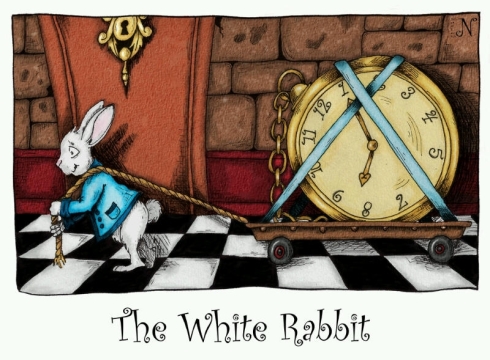
Art by Karien Naude
She was among the first batch of students to sign up for the Make Your Splashes Make Your Marks online course on illustrating children’s books. Somehow we were friends from the start — because Karien is, well, that sort of a person. Even my mother wants to adopt her. (Unofficially she has, with Karien’s bemused consent — though I should say Karien has loving parents and family in South Africa.) She’s very much a citizen of the world, with a network of artist friends that extends to the Austin, Texas SCBWI illustrators’ community, to New York, the UK and New Zealand to mention just a few places.
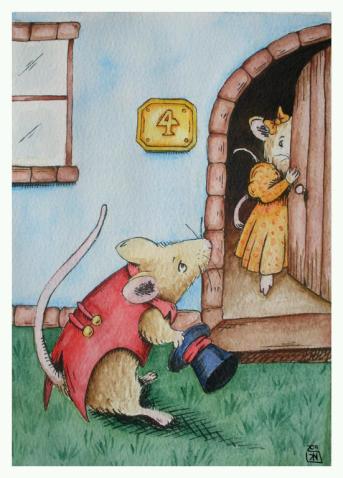
Karien's telling of a Sherlock Holmes tale
A lot has happened since 2009. She’s gone full time as a free-lancer, for one thing. Along the way she’s learned, taught herself, tons about the craft and business of illustration. So it really is time for another visit.
She agreed two years ago to serve as a bit of a guinea pig for the ongoing experiment of my online course and so she’s actually been ready for us to check in with her.
She’s a huge Tolkien and Terry Pratchett fan. She’s been on safaris. She loves to cook and loves music so much so that you’ll rarely catch her drawing or painting without her earphones on
Oxford University Press has appointed Casper Grathwohl to the newly-created role of senior vice-president, group strategy.
Grathwohl, who is currently vice president of reference and digital publishing within OUP's global academic division, will move into the new position on 5th October, reporting to c.e.o. Nigel Portwood. He will work at group level and alongside OUP's business units on a range of activities designed to address OUP's strategic agenda.
read more

This week, Workman Publishing is hiring a manager of digital sales and promotions, while Oxford University Press is on the hunt for a new art director. Penguin is seeking a designer for its advertising and promotion department, and Duke University Press is in need of an assistant managing editor. Get the details on these gigs and more below, and check out additional just-posted jobs on mediabistro.com.

For more job listings, go to the Mediabistro job board, and to post a job, visit our employer page. For real-time openings and employment news, follow @MBJobPost.
New Career Opportunities Daily: The best jobs in media.

This week, Macmillan is looking for an online marketing manager, while Hachette Book Group needs a new publicity director for its Nashville division. Disney/ABC is seeking a senior production editor for Hyperion and Voice, and Quirk Books is hiring a subsidiary rights manager. Get all the details on these gigs and more below, and check out additional just-posted jobs on mediabistro.com.

For more job listings, go to the Mediabistro job board, and to post a job, visit our employer page. For real-time openings and employment news, follow @MBJobPost.
New Career Opportunities Daily: The best jobs in media.

Are you artistic? This week, Macmillan is hiring an associate designer, and Scholastic is actively seeing an art director. Meanwhile, Bedford/St. Martin’s has launched a search for a new marketing manager, and Oxford University Press is looking for music and art editor. Get all the details on these great jobs and more below, and check out additional publishing gigs on mediabistro.com.

For more job listings, go to the Mediabistro job board, and to post a job, visit our employer page. For real-time openings and employment news, follow @MBJobPost.
New Career Opportunities Daily: The best jobs in media.

This week, Random House has a brand-new opening for an imprint sales manager, and Penguin is on the hunt for an eBook production editor/managing editor. BowTie Inc. has a great book sales manager position available, and Oxford University Press is hiring an online editor. Check out these publishing jobs and more below, and find additional new openings on mediabistro.com.

For more job listings, go to the Mediabistro job board, and to post a job, visit our employer page. For real-time openings and employment news, follow @MBJobPost.
New Career Opportunities Daily: The best jobs in media.

By:
Heidi MacDonald,
on 1/30/2011
Blog:
PW -The Beat
(
Login to Add to MyJacketFlap)
JacketFlap tags:
Marvel,
First Second,
Dark Horse,
Image,
IDW,
Drawn & Quarterly,
Oxford University Press,
Harper Collins,
Oni,
Campfire,
SLG/Slave Labor,
Coming Attractions,
Archaia,
D&Q,
Hermes Press,
Cinebook,
Penguin Publishing,
SQP,
Titan Books,
Add a tag
February has only 28 days, but is jam-packed with lots of great graphic novels and related titles!
Warning… looking at what appears so far on BarnesAndNoble.com, the rest of 2011 is going to be just as amazing! Click this link
to discover more! (
Sweet Kirby Crackle! Corto Maltese, in English, from Rizzoli?!) Better start shopping for bookshelves now.
Since this list takes a lot of work, I will not be adding hyperlinks to the publishers or BN.com. Most browsers allow you to search directly just by highlighting a term, or feel free to cut and paste into whichever web browser you prefer.
As always, I work for Barnes & Noble, but do not speak for them. These are titles which caught my interest, and are worth a closer work. I have not read any of these books (perhaps a comic here or there) so do not endorse any specific title on this list. My tastes are not yours, so please recommend other titles below in the comments! Also, the information below is subject to change. Covers, publication dates, prices, formats… all data are subject to changes.
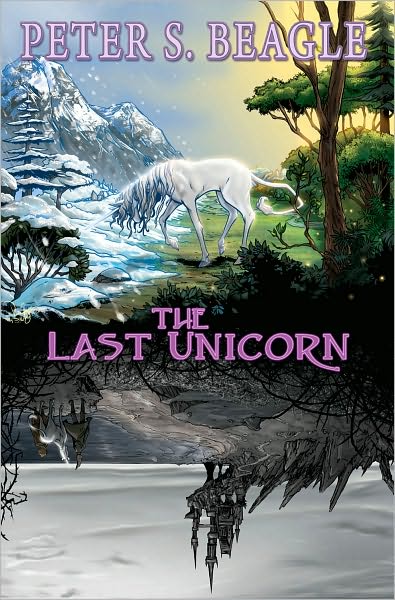
The Last Unicorn
by Peter S. Beagle, Peter Gillis, Renae DeLiz (Artist), Ray Dillon (Artist)
- $ 24.99
- Pub. Date: February 2011
- Publisher: Idea & Design Works, LLC
- Format: Hardcover, 152pp
- ISBN-13: 9781600108518
- ISBN: 1600108512

Stolen Hearts: The Love of Eros and Psyche
by Ryan Foley, Sankha Banerjee (Illustrator)
- $ 11.99
- Pub. Date: February 2011
- Publisher: Steerforth Press
- Format: Paperback , 88pp
- ISBN-13: 9789380028484
- ISBN: 9380028482
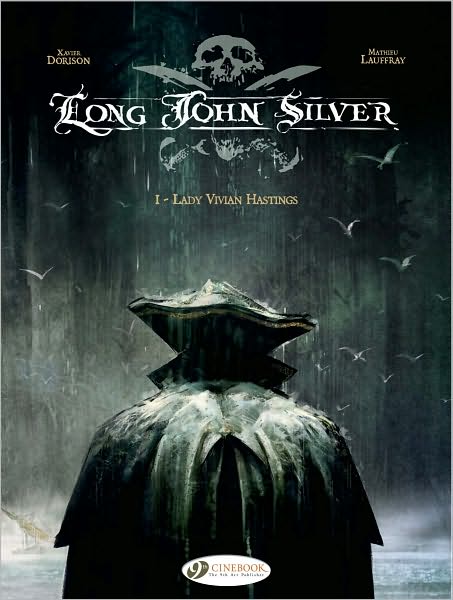
Lady Vivian Hastings: Long John Silver Volume 1
by Xavier Dorison, Mathieu Lauffray (Illustrator)
- $ 13.95
- Pub. Date: February 2011
- Publisher: Cinebook, LTD
- Format: Paperback, 56pp
- ISBN-13: 9781849180627
- ISBN: 1849180628
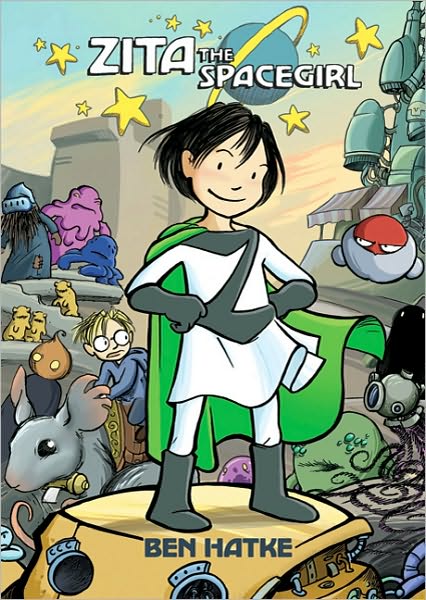
Zita

By:
Aline Pereira,
on 1/14/2011
Blog:
PaperTigers
(
Login to Add to MyJacketFlap)
JacketFlap tags:
Poetry Friday,
United Kingdom,
Oxford University Press,
Poetry Books,
Cat Stevens,
Edward Ardizzone,
Kaleidoscope,
Eleanor Farjeon,
Eerdmans,
Tim Ladwig,
Writing the World for Kids,
Add a tag
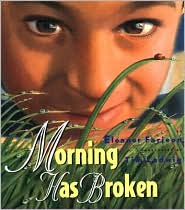 Last year I did a Poetry Friday post on an anthology of children’s poems that featured a book called Inner Chimes. I excerpted a snippet of a poem I liked by British writer Eleanor Farjeon (1881-1965) and as a result became curious about her. After reading her biography, I sought out her books. Our local library did not have lot of her books available for loan. Many are out-of-print and some, in fact, were housed in the juvenile reference section which require special permission to view. One book, however, of her most famous hymn-poem “Morning Has Broken” was available in a picture book format illustrated by Tim Ladwig (Eerdmans, 1996) I took it out and read it to my daughter, and then showed her a Youtube of Cat Stevens‘ famous rendition of the hymn. It was a great way to enjoy the poem! I was also able to take out Kaleidoscope (illustrated by Edward Ardizzone, Oxford University Pres, 1963.) Kaleidoscope is a collection of short lyrical sketches about a young boy named Anthony and his childish but deeply poetic perceptions of the world. In her Foreword, Farjeon explains
Last year I did a Poetry Friday post on an anthology of children’s poems that featured a book called Inner Chimes. I excerpted a snippet of a poem I liked by British writer Eleanor Farjeon (1881-1965) and as a result became curious about her. After reading her biography, I sought out her books. Our local library did not have lot of her books available for loan. Many are out-of-print and some, in fact, were housed in the juvenile reference section which require special permission to view. One book, however, of her most famous hymn-poem “Morning Has Broken” was available in a picture book format illustrated by Tim Ladwig (Eerdmans, 1996) I took it out and read it to my daughter, and then showed her a Youtube of Cat Stevens‘ famous rendition of the hymn. It was a great way to enjoy the poem! I was also able to take out Kaleidoscope (illustrated by Edward Ardizzone, Oxford University Pres, 1963.) Kaleidoscope is a collection of short lyrical sketches about a young boy named Anthony and his childish but deeply poetic perceptions of the world. In her Foreword, Farjeon explains how the character of Anthony was based on a poet acquaintance of hers who had grown up in the countryside. As writers, they shared memories of their past childhood — hers of a girl growing up in London and he as a boy in Somerset. I was impressed by these prose sketches by Farjeon, seemingly lighthearted in tone, but profoundly perceptive at the same time. She seemed to capture that essential childish awe and wonder that is of the nature of the poet, who perceives and then delights in words. As old as the book is, it does not feel dated; the observations are not sentimental nor trite. I enjoyed reading these sketches, mostly for myself although I did try reading a couple to my daughter. If you can find Farjeon’s books in your library, I’d recommend seeking them out. They are little treasures from the past, well worth savoring today.
how the character of Anthony was based on a poet acquaintance of hers who had grown up in the countryside. As writers, they shared memories of their past childhood — hers of a girl growing up in London and he as a boy in Somerset. I was impressed by these prose sketches by Farjeon, seemingly lighthearted in tone, but profoundly perceptive at the same time. She seemed to capture that essential childish awe and wonder that is of the nature of the poet, who perceives and then delights in words. As old as the book is, it does not feel dated; the observations are not sentimental nor trite. I enjoyed reading these sketches, mostly for myself although I did try reading a couple to my daughter. If you can find Farjeon’s books in your library, I’d recommend seeking them out. They are little treasures from the past, well worth savoring today.
This week’s Poetry Friday host is Laura at Writing the World for Kids.

It was a lively week fueled largely by misinformation as talk about the Oxford University Press filled blogs and flooded news columns across the Web. “The king’s book may never be seen in print again,” they cried. “Did you hear about those words that were added? What could the king be thinking to allow the lowly words of mere peasants into the holy grail of dictionaries?” For anyone who thought that Dick Snary was companion only to writers and other word-geeks this hoopla was surely a wake-up call. What was the underlying reason for the ruckus? If a book is not available in print do we fear we are being denied the information? If words we consider crass are acknowledged and accepted by a credible source does that somehow dilute the “purity” of our language?
The English language has an almost limitless ability to expand and develop. This is good news for those of us who want to continue to communicate the never-ending evolution of thoughts and ideas. Our ability to express is limited only by our own imagination--or sometimes by our editor—not by printed decree of the king. This is a language created by the people; the use of which can be neither denied nor muffled. It can, however, be recorded.
This brings us back to Oxford University Press and some necessary clarifications:
The Oxford English Dictionary (OED) has not yet been printed. The ODE just revised RH--rococoesque and added the section to their draft for the new edition. A couple hundred words were added, mostly in this category, and there were some changes made in sub-categories. The new edition will probably be finished around the year 2020. Retail cost for a published volume set is estimated at $995. No final decision has been made regarding the cessation of printed volumes. The
OED is accessible online for a fee. Why pay for access to an online dictionary when you can look up a word for free? The OED is a historical dictionary as opposed to a current-use dictionary; it is more like an encyclopedic language reference.
It is the new edition the
Oxford Dictionary of English (ODE) which was just released along with its cousin, The
New Oxford American Dictionary. These works are where the 2000 new words appear including Muggle, staycation, paywall and unfriend. The ODE and the NOAD are compilations of the common usage of words.
Dictionaries reflect of our ever changing culture. They provide a window into the social habits and communications of our neighbors and a historical reference for generations to come. Consider all the many forms available to us today. We have dictionaries of medieval words, slang dictionaries in almost every language, and urban dictionaries in which everyday people post new phrases daily. Instead of worrying about what words are added to them let us celebrate what they represent-- our passion for words.

By: LaurenA,
on 10/30/2009
Blog:
OUPblog
(
Login to Add to MyJacketFlap)
JacketFlap tags:
Reference,
Historical,
Oxford,
Press,
A-Featured,
Lexicography,
Dictionaries,
Oxford University Press,
English,
oed,
oxford english dictionary,
Dictionary,
University,
Thesaurus,
Historical Thesaurus,
HTOED,
Judy Pearsall,
Judy,
Pearsall,
Add a tag
Lauren, Publicity Assistant
It’s sad, but true. Historical Thesaurus week has come to an end. We feel like we’ve read it cover to cover (to cover to cover) and it’s hard to let go. And so, I’d like to leave you with a valuable lesson I learned: how to use the HTOED to call someone “stupid” in Old English. In this video post, Judy Pearsall (OUP’s Reference Publishing Manager) discusses how words are connected to one another in a HTOED entry, using the example of “foolish person.” Watch the video after the jump.
Click here to view the embedded video.


By: Kirsty,
on 10/29/2009
Blog:
OUPblog
(
Login to Add to MyJacketFlap)
JacketFlap tags:
Christian Kay,
HTOED,
Reference,
UK,
A-Featured,
Dictionaries,
A-Editor's Picks,
Oxford University Press,
oxford english dictionary,
university of glasgow,
Add a tag

Professor Christian Kay joined the Historical Thesaurus of the Oxford English Dictionary project in 1969, working on it right up to publication this month. In this original post, she reflects on the successes and challenges of forty years’ work on this amazing feat of scholarship.
Click here to read more OUPblog posts on the HTOED.
Publication of the Historical Thesaurus of the Oxford English Dictionary (HTOED) took place on 22nd October 2009. It was celebrated by a party at Glasgow University, where the project was developed, attended by over 100 people. I was proud to be one of them.
The project was started in 1965 by Professor M. L. Samuels, who, at the age of 89, was present at the party and gave a short talk. Also on the platform was another founder member, Professor Jane Roberts, who supplemented our Oxford English Dictionary-based data with material from Old English (c700 to 1150 AD) not included in the OED. The quartet of editors was completed by Irené Wotherspoon and myself, both of whom joined the project in 1969, as Research Assistants funded by the Leverhulme Trust. By that time, Irené was completing the first postgraduate thesis based on Historical Thesaurus materials, A Notional Classification of Two Parts of English Lexis.
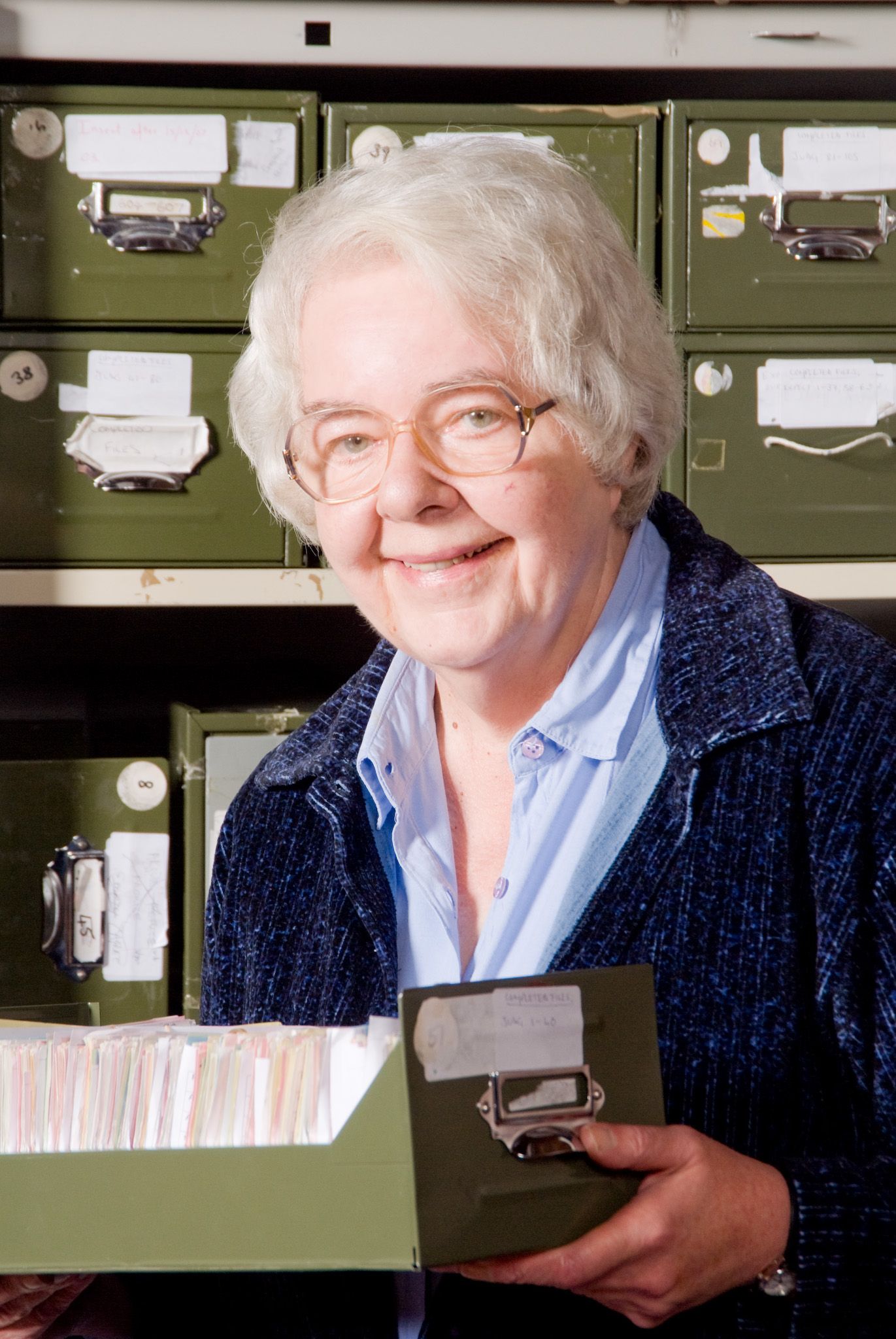 The appointment of Irené and myself was a significant departure for the project in that it was an acknowledgment that it would never be completed without full-time assistance – originally it had been conceived as a research activity for teaching staff and graduate students. We settled down with our volumes of the OED and our packets of paper slips to compile data for inclusion in the thesaurus. My first letter was L, which contains some very challenging words, such as ‘lay’ and ‘lie’, whose meanings I had to distribute around the semantic categories of the work.
The appointment of Irené and myself was a significant departure for the project in that it was an acknowledgment that it would never be completed without full-time assistance – originally it had been conceived as a research activity for teaching staff and graduate students. We settled down with our volumes of the OED and our packets of paper slips to compile data for inclusion in the thesaurus. My first letter was L, which contains some very challenging words, such as ‘lay’ and ‘lie’, whose meanings I had to distribute around the semantic categories of the work.
The 1970’s brought other challenges. Michael Samuels and I started working on a system of classification suited to large amounts of historical data, and we began recruiting doctoral students to work on specific sections of data, such as Religion or Goodness. We also faced a situation which was to become horribly familiar: running out of money. My job became part-time, and I supplemented my income by freelance work for publishers and writing textbooks. The situation was saved for me in 1979, when I became a full-time lecturer in the English Language Department. Irené had already departed for the south of England, where she raised three children and continued to work freelance for HTOED.
The downside of having a more secure job (‘at last’, said my family) was having less time for project work. In addition to my new role as a teacher, I found myself increasingly involved with thesaurus administration. We took our first tentative steps into computing at the urging of OUP, who wanted the project delivered electronically, and I spent much time in mutually uncomprehending discussions with computing experts. I also developed skills in fund-raising and people management: in the 1980’s we began to take on trainee lexicographers and typists to do preliminary classification and data entry. When Professor Samuels retired in 1989, I took over the administration completely.
The ever-present question, asked repeatedly by funders, University authorities, and OUP, was “When will the project 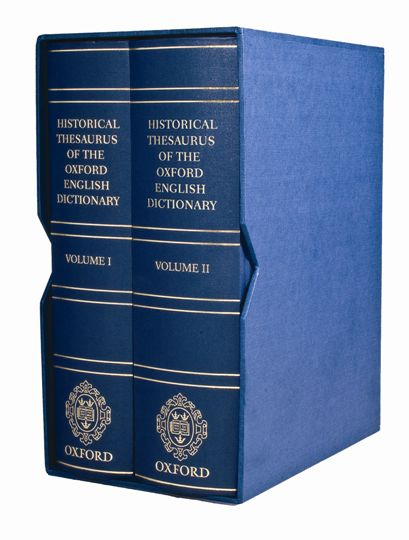 be finished?” This was a difficult question to answer, and involved such arcane skills as calculating the number of slips to a filing drawer, multiplying by the number of drawers, and working out the percentage completed in relation to the total in the OED. We came close to finishing in the early 1980’s, when we completed slip-making for the first edition of the OED, but by that time OUP had started producing supplements, and then a second edition, so we ploughed on, combining slip-making with classification. For the remaining years of the project, funding became easier, and we were able to employ both full-time assistants and graduate students on a part-time basis. Overall, I calculate that about 230 people played an active part in the project during its 44-year history.
be finished?” This was a difficult question to answer, and involved such arcane skills as calculating the number of slips to a filing drawer, multiplying by the number of drawers, and working out the percentage completed in relation to the total in the OED. We came close to finishing in the early 1980’s, when we completed slip-making for the first edition of the OED, but by that time OUP had started producing supplements, and then a second edition, so we ploughed on, combining slip-making with classification. For the remaining years of the project, funding became easier, and we were able to employ both full-time assistants and graduate students on a part-time basis. Overall, I calculate that about 230 people played an active part in the project during its 44-year history.
Over the past few weeks, various people (mainly journalists) have asked me “Why did it take so long?” The answer is partly that we never had enough money, but also that work of this kind requires a good deal of careful human input. If you are faced with, say, 10,000 slips containing words which have something to do with Food or Music, arriving at an acceptable classification is not the work of a few hours.
Classification and data entry proceeded through the 1990’s and early 2000’s, with glimmers of light occasionally visible at the end of the tunnel. One highlight of this period was the publication in 1995 of A Thesaurus of Old English by Jane Roberts and myself, which proved that we could at least finish something. Another was my promotion to a professorship in 1996. However, the best moment of all came on 29th September 2008, when the disk containing the final text went off to OUP, followed in August 2009, after a tough period of proofreading, by the appearance in Glasgow of the first copy of HTOED.

View Next 7 Posts











 What’s your most obscure talent/hobby?
What’s your most obscure talent/hobby?













 The appointment of Irené and myself was a significant departure for the project in that it was an acknowledgment that it would never be completed without full-time assistance – originally it had been conceived as a research activity for teaching staff and graduate students. We settled down with our volumes of the OED and our packets of paper slips to compile data for inclusion in the thesaurus. My first letter was L, which contains some very challenging words, such as ‘lay’ and ‘lie’, whose meanings I had to distribute around the semantic categories of the work.
The appointment of Irené and myself was a significant departure for the project in that it was an acknowledgment that it would never be completed without full-time assistance – originally it had been conceived as a research activity for teaching staff and graduate students. We settled down with our volumes of the OED and our packets of paper slips to compile data for inclusion in the thesaurus. My first letter was L, which contains some very challenging words, such as ‘lay’ and ‘lie’, whose meanings I had to distribute around the semantic categories of the work. be finished?” This was a difficult question to answer, and involved such arcane skills as calculating the number of slips to a filing drawer, multiplying by the number of drawers, and working out the percentage completed in relation to the total in the OED. We came close to finishing in the early 1980’s, when we completed slip-making for the first edition of the OED, but by that time OUP had started producing supplements, and then a second edition, so we ploughed on, combining slip-making with classification. For the remaining years of the project, funding became easier, and we were able to employ both full-time assistants and graduate students on a part-time basis. Overall, I calculate that about 230 people played an active part in the project during its 44-year history.
be finished?” This was a difficult question to answer, and involved such arcane skills as calculating the number of slips to a filing drawer, multiplying by the number of drawers, and working out the percentage completed in relation to the total in the OED. We came close to finishing in the early 1980’s, when we completed slip-making for the first edition of the OED, but by that time OUP had started producing supplements, and then a second edition, so we ploughed on, combining slip-making with classification. For the remaining years of the project, funding became easier, and we were able to employ both full-time assistants and graduate students on a part-time basis. Overall, I calculate that about 230 people played an active part in the project during its 44-year history.
Karien, I love hearing stories like this. Your hard work and determination are helping you to realize your dreams! You’re story is inspiring!
It’s also wonderful to see how your work has progressed. I remember discussing your pigeon during one of our critique nights.